The dedicated One-Way ANOVA process is represented by the steps below.
However, as the One-Way ANOVA belongs to the family of statistical tests known as the General Linear Model (GLM), it can also be carried out using the Univariate GLM process (the term “univariate” refers to only one dependent variable).
This latter approach might be useful if your study contains more independent variables, fixed and random factors, weighting variables, and covariates than can be analyzed using a straightforward One-Way ANOVA (e.g., One-Way ANCOVA).
We continue by describing how to use the specific SPSS procedure for running a One-Way ANOVA.
- Click Analyze > Compare Means > One-Way ANOVA… on the top menu, as shown below.
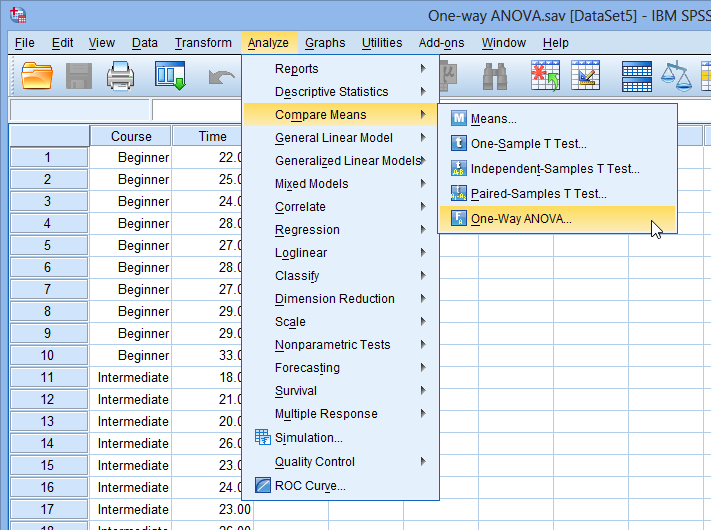
2. A dialogue box with the One-Way ANOVA will appear for you:
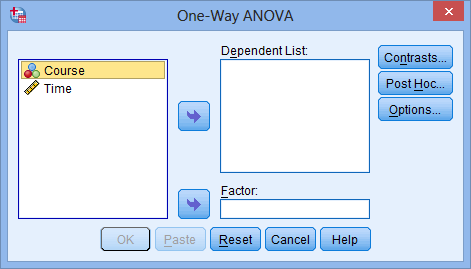
3. Use the proper Right arrow buttons (or drag and drop the variables into the boxes) to move the dependent variable, Time, into the Dependent List: box and the independent variable, Course, into the Factor: box, as shown below:
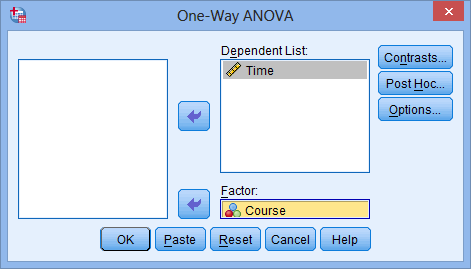
4. Click on the ![]() button. Check the box next to Tukey as indicated below:
button. Check the box next to Tukey as indicated below:
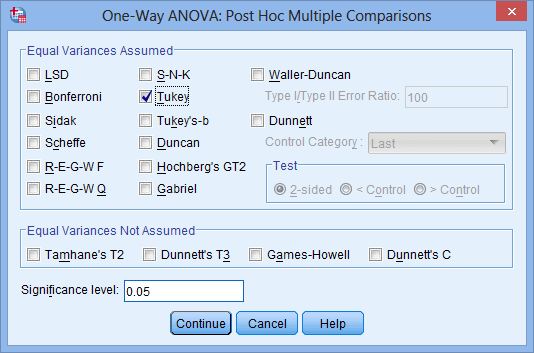
5. Click on the ![]() button.
button.
6. Click on the ![]() button. As illustrated below, check the Descriptive box in the statistics section.
button. As illustrated below, check the Descriptive box in the statistics section.

7. Click on the ![]() button.
button.
8. Click on the ![]() button.
button.
Outcome of the analysis
Descriptives Table
The descriptives table (see below) offers some extremely helpful descriptive statistics, such as the mean, standard deviation, and 95% confidence intervals for the dependent variable (Time), both individually for each group (Beginners, Intermediate, and Advanced), as well as when all groups are combined (Total). When you need to describe your data, these figures come in handy.

The results of the ANOVA analysis are shown in this table, along with a determination of whether there is a statistically significant difference between the group means. There is a statistically significant difference in the mean amount of time it takes to finish the spreadsheet issue between the three courses, as can be seen from the significance value of 0.021 (i.e., p =.021), which is below 0.05. Although this is excellent information, we are unaware of which particular groups differed. Fortunately, the Multiple Comparisons table, which includes the Tukey post hoc test findings, allows us to determine this.

Multiple Comparisons Table
As of now, the data indicate that the groups as a whole differ statistically significantly from one another. Multiple Comparisons reveals which groups were different from one another in the table below. Although there are many other options, the Tukey post hoc test is typically chosen when performing post hoc analyses on a one-way ANOVA. The table below shows that there is a statistically significant variation in the amount of time it took each group to finish the problem depending on whether they took the beginner course or the intermediate course (p = 0.046), as well as between the beginner course and advanced course (p = 0.034). The groups that took the intermediate and advanced courses did not differ from one another, though (p = 0.989).
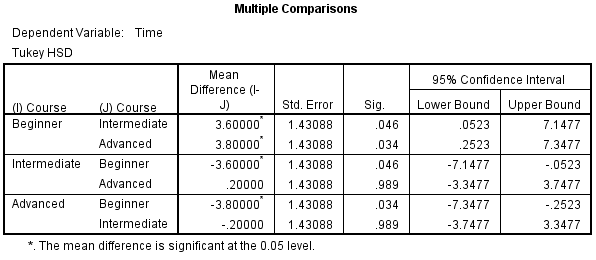
Contact Us for your Data Analysis and Interpretation
Statisda is a cutting-edge platform for research, econometrics, statistics, and forecasting that provides robust analytical tools with adaptable, clear interpretation. At Statisda, we manage your data quickly and effectively, carry out economic and statistical analysis, provide forecasts, simulate models, and create excellent visualizations. Send us a message for any question or query.
